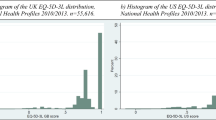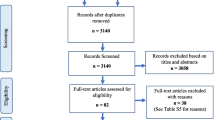Abstract
Purpose
Chronic diseases are associated with impaired health-related quality of life (HRQoL) outcomes. Comparison of HRQoL outcomes between different diseases and with the general population is of major importance to health economists, epidemiologists, clinicians, and policy makers. The aim of this systematic literature review was to develop a catalogue with EQ-5D scores in chronic non-communicable diseases, and to compare these scores with reference values from the general population.
Methods
MEDLINE, Embase, and Web of Science were systematically searched independently by two reviewers. Studies were included if they reported mean EQ-5D index values for the adult population and if these scores were compared with the general population. The QualSyst tool for quantitative research was used for quality appraisal.
Results
Two hundred and seven articles met the inclusion criteria. An extensive catalogue summarizes the EQ-5D scores in a wide variety of chronic diseases. Mean EQ-5D index values ranged between − 0.20 and 1. Lower EQ-5D scores are reported in chronic diseases compared to the general population, specifically in neurological disorders. Most of the diseases demonstrate a substantial disutility, although a minority of diseases have equal or even higher index scores than the general population.
Conclusion
A comprehensive, international catalogue has been developed to provide EQ-5D index scores for diverse chronic diseases compared with reference values based on the available literature. The catalogue gives a clear overview of the existing EQ-5D scores and can be rapidly accessed by researchers worldwide for different applications such as health economic evaluations, decision making, resource allocation, and other policy objectives. Future studies should focus on unexamined diseases and specific patient groups to expand the evidence base on HRQoL in chronic diseases.

Similar content being viewed by others
References
World Health Organization. (2014). Global status report on noncommunicable diseases 2014. Retrieved August, 1, 2018, from http://apps.who.int/iris/bitstream/handle/10665/148114/9789241564854_eng.pdf;jsessionid=DE930A0A052CB03AB73898D75695E8F7?sequence=1.
World Health Organization. (2013). Global action plan for the prevention and control of noncommunicable diseases 2013–2020. Retrieved August, 1, 2018, from http://apps.who.int/iris/bitstream/handle/10665/94384/9789241506236_eng.pdf?sequence=1.
Megari, K. (2013). Quality of life in chronic disease patients. Health Psychology Research,1(3), e27.
GBD 2016 Disease and Injury Incidence and Prevalence Collaborators. (2018). Global, regional, and national incidence, prevalence, and years lived with disability for 354 diseases and injuries for 195 countries and territories, 1990–2017: A systematic analysis for the Global Burden of Disease Study 2017. The Lancet,392(10159), 1789–1858.
Schipper, H., & Olweny, C. (1996). Quality of life studies: definitions and conceptual issues. In B. Spilker (Ed.), Quality of Life and Pharmacoeconomics in Clinical Trials (pp. 11–23). Philadelphia: Lippincott-Raven Publishers.
Grool, A. M., van der Graaf, Y., Visseren, F. L., de Borst, G. J., Algra, A., & Geerlings, M. I. (2012). Self-rated health status as a risk factor for future vascular events and mortality in patients with symptomatic and asymptomatic atherosclerotic disease: The SMART study. Journal of Internal Medicine,272(3), 277–286.
Spertus, J. A., Jones, P., McDonell, M., Fan, V., & Fihn, S. D. (2002). Health status predicts long-term outcome in outpatients with coronary disease. Circulation,106(1), 43–49.
Mapes, D. L., Lopes, A. A., Satayathum, S., McCullough, K. P., Goodkin, D. A., Locatelli, F., et al. (2003). Health-related quality of life as a predictor of mortality and hospitalization: The Dialysis Outcomes and Practice Patterns Study (DOPPS). Kidney International,64(1), 339–349.
Kind, P., Lafata, J. E., Matuszewski, K., & Raisch, D. (2009). The use of QALYs in clinical and patient decision-making: Issues and prospects. Value Health,12(Suppl 1), S27–S30.
Ko, Y., & Coons, S. J. (2006). Self-reported chronic conditions and EQ-5D index scores in the US adult population. Current Medical Research and Opinion,22(10), 2065–2071.
Whitehead, S. J., & Ali, S. (2010). Health outcomes in economic evaluation: The QALY and utilities. British Medical Bulletin,96, 5–21.
Kang, E. J., & Ko, S. K. (2009). A catalogue of EQ-5D utility weights for chronic diseases among noninstitutionalized community residents in Korea. Value Health,12(Suppl 3), S114–S117.
Dolan, P. (1997). Modeling valuations for EuroQol health states. Medical Care,35(11), 1095–1108.
Group, T. E. (1990). EuroQol—A new facility for the measurement of health-related quality of life. Health Policy,16(3), 199–208.
Sullivan, P. W., Slejko, J. F., Sculpher, M. J., & Ghushchyan, V. (2011). Catalogue of EQ-5D scores for the United Kingdom. Medical Decision Making,31(6), 800–804.
Dyer, M. T., Goldsmith, K. A., Sharples, L. S., & Buxton, M. J. (2010). A review of health utilities using the EQ-5D in studies of cardiovascular disease. Health and Quality of Life Outcomes,8, 13.
Sassi, F. (2006). Calculating QALYs, comparing QALY and DALY calculations. Health Policy Plan,21(5), 402–408.
JPT, H. (2011). Cochrane Handbook for Systematic Reviews of Interventions Version 5.1.0. The Cochrane Collaboration. Retrieved April, 24, 2018, from www.handbook.cochrane.org.
McGowan, J., Sampson, M., Salzwedel, D. M., Cogo, E., Foerster, V., & Lefebvre, C. (2016). PRESS peer review of electronic search strategies: 2015 Guideline Statement. Journal of Clinical Epidemiology,75, 40–46.
Kmet, L. M., & Cook, L. S. (2004). Standard quality assessment criteria for evaluating primary research papers from a variety of fields. Alberta Heritage Foundation for Medical Research (AHFMR),2011, 1–22.
Bramer, G. R. (1988). International statistical classification of diseases and related health problems. Tenth revision. World Health Stat Q,41(1), 32–36.
Devlin, N. J., & Brooks, R. (2017). EQ-5D and the EuroQol Group: Past, present and future. Applied Health Economics and Health Policy,15(2), 127–137.
National Institute for Health and Clinical Excellence (NICE). (2013). Guide to the Methods of Technology Appraisal. London: NICE.
Cohen, R. D. (2002). The quality of life in patients with Crohn’s disease. Alimentary Pharmacology & Therapeutics,16(9), 1603–1609.
de Jong, W., Kaptein, A. A., van der Schans, C. P., Mannes, G. P., van Aalderen, W. M., Grevink, R. G., et al. (1997). Quality of life in patients with cystic fibrosis. Pediatric Pulmonology,23(2), 95–100.
Coman, A. C., Borzan, C., Vesa, C. S., & Todea, D. A. (2016). Obstructive sleep apnea syndrome and the quality of life. Clujul Medical,89(3), 390.
Muller-Nordhorn, J., Roll, S., Bohmig, M., Nocon, M., Reich, A., Braun, C., et al. (2006). Health-related quality of life in patients with pancreatic cancer. Digestion,74(2), 118–125.
van der Have, M., van der Aalst, K. S., Kaptein, A. A., Leenders, M., Siersema, P. D., Oldenburg, B., et al. (2014). Determinants of health-related quality of life in Crohn’s disease: A systematic review and meta-analysis. J Crohns Colitis,8(2), 93–106.
Zhao, C., Wong, L., Zhu, Q., & Yang, H. (2018). Prevalence and correlates of chronic diseases in an elderly population: A community-based survey in Haikou. PLoS ONE,13(6), e0199006.
Wolff, J. L., Starfield, B., & Anderson, G. (2002). Prevalence, expenditures, and complications of multiple chronic conditions in the elderly. Archives of Internal Medicine,162(20), 2269–2276.
Sullivan, P. W., Lawrence, W. F., & Ghushchyan, V. (2005). A national catalog of preference-based scores for chronic conditions in the United States. Medical Care,43(7), 736–749.
Cherepanov, D., Palta, M., Fryback, D. G., & Robert, S. A. (2010). Gender differences in health-related quality-of-life are partly explained by sociodemographic and socioeconomic variation between adult men and women in the US: Evidence from four US nationally representative data sets. Quality of Life Research,19(8), 1115–1124.
Kind, P., Dolan, P., Gudex, C., & Williams, A. (1998). Variations in population health status: Results from a United Kingdom national questionnaire survey. BMJ,316(7133), 736–741.
Hajian-Tilaki, K., Heidari, B., & Hajian-Tilaki, A. (2017). Are gender differences in health-related quality of life attributable to sociodemographic characteristics and chronic disease conditions in elderly people? Int J Prev Med,8, 95.
Saarni, S. I., Harkanen, T., Sintonen, H., Suvisaari, J., Koskinen, S., Aromaa, A., et al. (2006). The impact of 29 chronic conditions on health-related quality of life: A general population survey in Finland using 15D and EQ-5D. Quality of Life Research,15(8), 1403–1414.
Wailoo, A., Hernandez Alava, M., Grimm, S., Pudney, S., Gomes, M., & Sadique, Z. (2017). Comparing the EQ-5D-3L and 5L versions. What are the implications for cost effectiveness estimates?
Subramaniam, M., Soh, P., Vaingankar, J. A., Picco, L., & Chong, S. A. (2013). Quality of life in obsessive-compulsive disorder: Impact of the disorder and of treatment. CNS Drugs,27(5), 367–383.
Shrive, F. M., Ghali, W. A., Johnson, J. A., Donaldson, C., & Manns, B. J. (2007). Use of the U.S. and U.K. scoring algorithm for the EuroQol-5D in an economic evaluation of cardiac care. Medical Care,45(3), 269–273.
Tengs, T. O., & Wallace, A. (2000). One thousand health-related quality-of-life estimates. Medical Care,38(6), 583–637.
Zhao, Y., Li, S. P., Liu, L., Zhang, J. L., & Chen, G. (2017). Does the choice of tariff matter? A comparison of EQ-5D-5L utility scores using Chinese, UK, and Japanese tariffs on patients with psoriasis vulgaris in Central South China. Medicine (Baltimore),96(34), e7840.
Dolan, P. (1997). Aggregating health state valuations. J Health Serv Res Policy,2(3), 160–165. (discussion 166–167).
De Smedt, D., Clays, E., Annemans, L., & De Bacquer, D. (2014). EQ-5D versus SF-12 in coronary patients: Are they interchangeable? Value Health,17(1), 84–89.
Funding
This study was funded by a Grant from Ghent University (Grant No. 01N02618) (Bijzonder Onderzoeksfonds, BOF).
Author information
Authors and Affiliations
Corresponding author
Ethics declarations
Conflict of interest
The authors declare that they have no conflict of interest.
Additional information
Publisher's Note
Springer Nature remains neutral with regard to jurisdictional claims in published maps and institutional affiliations.
Electronic supplementary material
Below is the link to the electronic supplementary material.
Rights and permissions
About this article
Cite this article
Van Wilder, L., Rammant, E., Clays, E. et al. A comprehensive catalogue of EQ-5D scores in chronic disease: results of a systematic review. Qual Life Res 28, 3153–3161 (2019). https://doi.org/10.1007/s11136-019-02300-y
Accepted:
Published:
Issue Date:
DOI: https://doi.org/10.1007/s11136-019-02300-y




